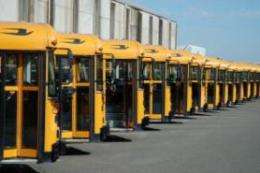A three-member research team investigated student and teacher perceptions of school safety around the state. In a published article reporting the findings, the team noted that while the Centers for Disease Control and Prevention has reported a decline in decrease in school violence, safety remains an important concern as certain threats persist.
(PhysOrg.com) -- Kris Bosworth, a UA College of Education faculty member, led an investigation into the perceptions students and teachers throughout Arizona hold about campus safety, finding that each school's climate plays a large role in what people believe.
When it comes to school safety, some believe that schools in more affluent neighborhoods are better off or that the presence of gates and security guards make people feel safer.
Yet, a University of Arizona research team's investigation resulted in some interesting, contrasting findings after interviewing students and teachers from around Arizona.
Students were more likely to report higher perceptions of safety when visible security measures such as security officers and gates were present.
But about 60 percent of the time, students and teachers were more apt to be concerned with school climate – the ways students and teachers engage, how teachers connect with one another and what behaviors are reinforced throughout the school.
"Appearing to be safer doesn't necessarily mean that the school is safer," said Kris Bosworth, the Lester L. and Roberta D. Smith Endowed Chair in Education. "You can't tell a book by its cover."
Bosworth, a faculty member in the UA College of Education, led the study of student and teacher perceptions about school safety.
She co-authored an article on the findings with two students: Lysbeth Floden, a graduate student focusing on biostatistics in the UA Mel and Enid Zuckerman College of Public Health, and Diley Hernandez, who has since earned her graduate degree in education psychology.
The article, "School Climate Factors Contributing to Student and Faculty Perceptions of Safety in Select Arizona Schools," was published this month in the Journal of School Health.
Speaking directly to students and teachers is in contrast to most other investigations on school safety. Other studies have tended to rely more heavily on reports – those drafted by law enforcement officials and others detailing disciplinary actions, such as suspensions and expulsion.
In their evaluation, Bosworth, Floden and Hernandez surveyed 22 groups of students and teachers at 11 schools around the state of varying size, type and location.
The team considered the presence of cameras, fences, lighting, monitors, locked doors and gates.
The research trio also considered school size, location, fire drill practices and also emergency and school discipline policies among numerous other factors to interpret why different views about perceived safety might exist between students and teachers.
Overwhelmingly, school environment and interactions between students and staff members were key features in determining whether students and teachers felt safe.
Bosworth said: "We want kids to respect one another, but if we don't show that respect – if the adults don't care – why should the kids care?"
The study's results has informed another project Bosworth is helping to facilitate – the Safe Supportive Schools project.
Bosworth is principal investigator on the UA's $1.2 million subcontract as part of a nearly $5.9 million grant to Arizona from the U.S. Department of Education. The project is designed to help schools around the state address campus climate issues.
Another major finding is in direct opposition to established perceptions about schools based on location and performance.
The team noted in the article, "High student performance on
standardized tests does not buffer students from unsafe behavior, nor does living in a dangerous neighborhood necessarily lead to more drug use or violence within school walls."
The article continued, "Overall, the level of organization and the climate of the school appear to be more influential factors on perceptions of school safety than academic achievement or geographic location."
That is to say in addition to physical structures, perceptions also are shaped by whether teachers listen to their students and work as productive teams, whether students are comfortable around one another and if people have positive attitudes.
The article concludes, "Academic success does not buffer students from risky behavior or from feeling unsafe. Rather, both adults and students felt safe in schools where they perceived that adults were caring and helpful, and rules were clear, consistent, well communicated, and consistently applied."
The implications, then, are varied, Bosworth said.
Critically important are clear rules, regulations and procedures related to behavior. Also, educators must ensure that all members of their schools are promoting a healthy and caring environment.
"Based on what we are finding, if you feel safe, it is easier for you to learn. The brain isn't ready to learn if there is fear," Bosworth said.
"We adults," she said, "have a huge responsibility to ensure that our students feel safe and that they are safe."
Provided by University of Arizona



















